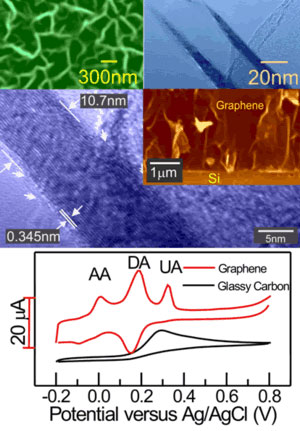| Posted: October 21, 2008 |
Researchers discover new class of graphene-based electrodes |
|
(Nanowerk News) Graphene is the latest nanoscale form of carbon to be discovered and it is currently the hottest topic in condensed matter physics and materials science due to its novel electronic properties. An important feature of graphene, which has not been exploited so far, has been its edges, where interesting electrocatalytic properties and sites for functionalization can develop.
|
|
Graphene itself does not occur naturally and it is extremely difficult to synthesize, manipulate and process in ways that allow it to be integrated into devices on large scales. Therefore it is desirable to develop reliable and large scale production of graphene for practical applications.
|
|
Researchers at the University of Ulster (Dr P.Papakonstantinou and Dr N. Shang) have developed new strategies to exploit the efficient growth, electrocatalytic properties and high surface area of graphene sheets. To do that they have integrated a large number of vertical graphene sheets into a platform, where rich edge planes/defects terminate on the surface, using a one-step microwave plasma enhanced chemical vapour deposition approach. Using this platform they successfully demonstrated their fast electron transfer, excellent electrocatalytic and biosensing properties for the first time.
|
 |
| High-purity multilayer graphene nanoflake films are efficiently grown on Si by a simple method without use of catalysts. They are made of interlaced highly graphitized, abundant knife-edge nanoflakes with a 2-3 nm thick edge and have a preferentially vertical orientation. They demonstrate well resolved simultaneous discrimination of dopamine, ascorbic acid and uric acid much better than glassy carbon electrode.
|
|
Their work has appeared in the Journal of Advanced Functional Materials ("Catalyst-Free Efficient Growth, Orientation and Biosensing Properties of Multilayer Graphene Nanoflake Films with Sharp Edge Planes"). |
|
Dopamine (DA) is a neurotransmitter that plays a very important role in the central nervous, renal, hormonal and cardiovascular systems. Changes in the concentration of DA are closely linked to human's health status and therefore are important to detect. When traditional electrodes are employed, the dopamine response is obscured by coexisting ascorbic acid (AA) and uric acid (UA) resulting in rather poor selectivity and sensitivity. However, the present graphene platform is able to identify and sense DA with high sensitivity.
|
|
The remarkable electrocatalytic and sensitive sensing properties are mainly due to the unique electronic structure of graphene, its rich edge defects and large surface area. In contrast to the multi-step fabrication procedures of other electrodes, the fabrication of the graphene platform is a simple, efficient one-step CVD process without time-consuming elaborate modification and/or functionalization procedures, which commonly lead to unstable and non-reproducible performance.
|
|
This work has created a new class of graphene based electrodes for a wide range of applications in the electroanalytical, biosensing, energy storage/conversion sectors and could essentially compete their vertically aligned carbon nanotubes counterparts.
|

